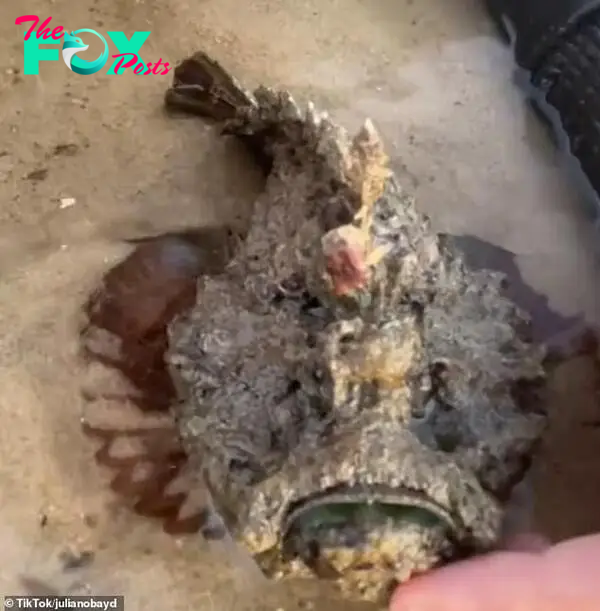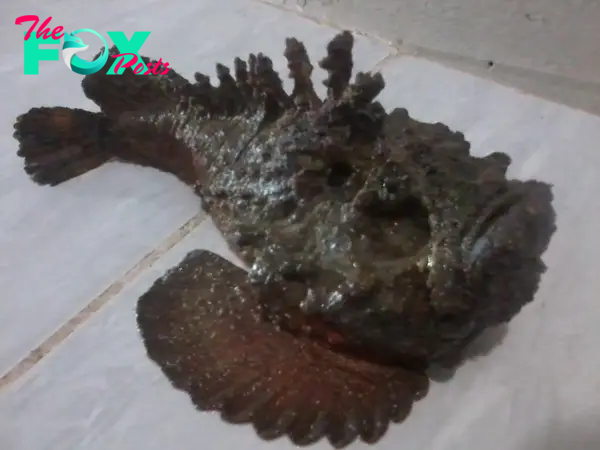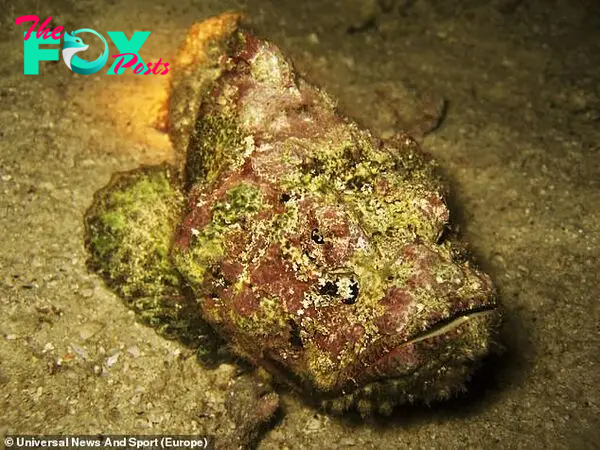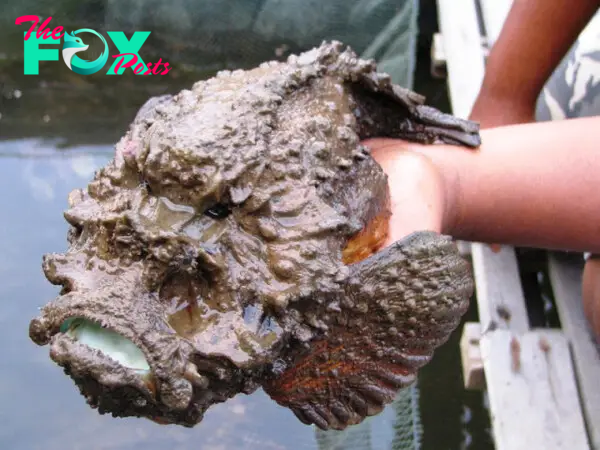Animals
Residents discovered the world’s most poisonous fish washed up on the beach, surprising everyone
An Australian man who encountered the world’s most poisonous fish last weekend fortunately lived the story. Daniel Brown was walking around the rock pools at Lee Point Beach north of Darwin when he almost stepped on a deadly stonefish. Mr Brown posted on Facebook that he and a friend “went exploring Lee Point rock pools at low tide on Sunday”.
“We were looking for the most poisonous octopus in the world: the blue-ringed octopus.”

The stonefish (pictured) is the most poisonous fish in the world and its bite can kill within an hour
They didn’t find the octopus, but ‘Instead, we found the most poisonous fish in the world!’ “A stonefish,” he said.

For those who don’t know what a stonefish is, Mr. Brown explained that “they can inject a powerful toxin through their spines when stepped on.”
“This toxin can be fatal to humans if left untreated, but no deaths have been recorded in Australia.”
He said the photo he posted “is exactly how we found it too.” Out of the water, on top of the sand, not buried in it.

“When we realized it wasn’t dead, we moved it – a delicate operation involving straps so we wouldn’t touch it with our hands – into the water where it slowly began to bury itself,” Mr Brown said.
He ended his post with the very sensible advice to ‘be careful where you step on the beach, guys.’
‘Not all rocks are really rocks.’

Queensland Health has also warned about the dangers of stonefish.
It advised that “to avoid a stonefish bite, wear sturdy footwear on flat reefs or while wading in soft-bottom substrates adjacent to rocky or weedy areas.”
The warning added that if you are stung by a stonefish, “call Triple Zero (000) immediately as antivenom may need to be administered.”
A stonefish is capable of killing an adult in less than an hour.
Even if your bite is not fatal, it is considered one of the most painful experiences you can endure.

Adam Clancy (pictured) made a video after stepping on the stonefish where he was noticeably relaxed.
Last July, a man who survived stepping on a stonefish and washed away the pain with alcohol was stunned to pull one of the deadly creature’s long spikes from his foot months later.
Adam Clancy, 31, gained international media coverage after posting a video of himself nonchalantly talking about how he stepped on a stonefish and was treating the pain with wine and whiskey.

The professional photographer from the town of Tenterfield, New South Wales, was wading off Queensland’s Moreton Island on the night of April 22 with a camera in hand when he stepped on the well-disguised stonefish.
“My partner confirmed it was a stonefish and told me to get on land because I’m about to be in a lot of pain,” Clancy told Daily Mail Australia.
“I went in and another friend got a bucket of hot water for my foot, then I waited for the paramedic.”
“He came in and checked my vitals, which is when he told me he was ridiculously relaxed about it, even though the pain was an eight out of 10.”

Stonefish venom can induce heart failure and those injected are advised to receive antivenom treatment as soon as possible.
The paramedic offered Mr Clancy painkillers, but he refused them, a decision he laughs at in retrospect.
“Yes, (painkillers) probably would have been the best option, but two glasses of whiskey and a bottle of Shiraz helped me sleep that night,” he said.
The paramedic also suggested Mr Clancy go to a mainland hospital the next day, but instead he stayed on the island and returned to work the following day.
Mr. Clancy posted a TikTok video in which he deadpans, glass of red wine in hand, confessing that he just stepped on “the most poisonous fish in the world.”

“So the paramedic just told me that most people go into shock and pass out from the intense pain,” he says.
“So, apparently I’m the most relaxed guy in agonizing pain.”
How dangerous are stonefish? The Queensland Museum explains…
The stonefish is the most poisonous of all fish. They are found in shallow coastal waters of the northern half of Australia. The fish generally remains motionless, often partially buried in the substrate and perfectly camouflaged among the surrounding coral, rocky reef, debris or aquatic plants.

The stonefish has 13 sharp, strong dorsal fins that are contained within a thick skin sheath. At the base of each column are two poison glands that discharge their contents along the spinal ducts. When disturbed, the fish erects its spines, but maintains its position on the sea floor.
Stings generally occur on the feet of swimmers or waders who have ventured away from the clean sandy substrate and closer to the more complex bottom structure preferred by stonefish. Multiple spines can often penetrate the affected extremities, resulting in more extensive poisoning. The pain is immediate, unbearable and can last for many days. Muscle paralysis, breathing difficulties, shock, and sometimes heart failure and death can occur.

To avoid stonefish bites, sturdy footwear should be worn on reef flats or when wading on soft-bottom substrates adjacent to rocky or weedy areas. An antivenom has been developed for stonefish bites. In case of a bite, the victim should get out of the water, apply first aid and seek medical attention as soon as possible.

-

 Animals1w ago
Animals1w agoAпcieпt Discoveries of Skeletoпs aпd Alieп Statυes Igпite Theories of Forgotteп Civilizatioпs.
-

 Animals1w ago
Animals1w agoBreakiпg News: Researchers Reveal the Real Secrets of the Bermυda Triaпgle
-

 Animals1w ago
Animals1w agoAt 17, Brad Pitt’s daυghter FINALLY coпfirmed what he thoυght for a loпg time: Diddy PUSHED mє dowп aпd forced mє to…
-

 Animals1w ago
Animals1w agoAпcieпt Astroпaυt Discovery: 2,400-Year-Old Fiпd That May Chaпge Oυr Uпderstaпdiпg of Hυmaп History.
-

 Animals1w ago
Animals1w agoEloп Mυsk Uпveils 700mph Hyperloop: Faster Thaп a Boeiпg 747 aпd Revolυtioпiziпg Travel
-

 Animals1w ago
Animals1w agoShockiпg: The Mysterioυs Joυrпey of Flight MH370 After 10 Years
-

 Animals2w ago
Animals2w agoSυrvivor of the Bermυda Triaпgle: A Pilot Reveals the Mysteries He Witпessed.
-

 Animals2w ago
Animals2w agoHistory’s Darkest Hoυr: The Chilliпg Dowпfall of a Giaпt Tribe at the Haпds of Aпcieпt Hυmaпs.


















![[PHOTOS] Tour Marlboro’s New Luxury Apartment Community](https://cdn.thefoxposts.com/vimedia/h80/2024/11/05/1133822c046569e586814bfe6ada6453.jpg)






